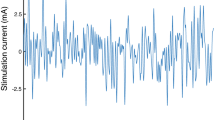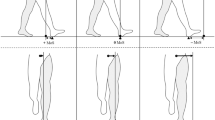Abstract
We asked what the role of the vestibular system is in adaptive control of locomotor trajectory in response to walking on a rotating disc. Subjects with bilateral vestibular loss (BVL) were compared to age- and gender-matched controls (CTRL). Subjects walked in place on the surface of a rotating disc for 15 min and then attempted to step in place without vision on a stationary surface for 30 min. CTRL subjects demonstrated podokinetic after-rotation (PKAR), involuntarily and unknowingly turning themselves in circles while attempting to step in place. PKAR in CTRLs was characterized by a rapid rise in turning velocity over the first 1–2 min, followed by a gradual decay over the remaining 28 min. Subjects with BVL also demonstrated PKAR and had no knowledge of their turning. However, PKAR in BVLs was characterized by an extremely rapid, essentially instantaneous rise. Subjects with BVL immediately turned at maximum velocity and exhibited a gradual decay throughout the entire 30 min period. Despite this difference in the initial portion of PKAR in BVLs, their responses were not significantly different from CTRLs during minutes 2 to 30 of the response. These results suggest that vestibular inputs normally suppress PKAR velocity over the first 1–2 min of the response, but do not greatly influence PKAR decay. PKAR is therefore a process mediated primarily by somatosensory information and vestibular inputs are not required for its expression. Additionally, the absence of vestibular inputs does not result in increased somatosensory sensitivity that alters podokinetic intensity or decay time constants.


Similar content being viewed by others
References
Becker W, Nasios G, Raab S, Jurgens R (2002) Fusion of vestibular and podokinesthetic information during self-turning towards instructed targets. Exp Brain Res 144:458–474
Bles W, Roos JW (1991) The tilting room and posturography. Acta Otorhinolaryngol Belg 45:387–391
Dietz V, Baaken B, Colombo G (2001) Proprioceptive input overrides vestibulospinal drive during human locomotion. Neuroreport 12:2743–2746
Glasauer S, Amorim M-A, Vitte E, Berthoz A (1994) Goal-directed linear locomotion in normal and labyrinthine-defective subjects. Exp Brain Res 98:323–335
Gordon CR, Fletcher WA, Melvill Jones G, Block EW (1995) Adaptive plasticity in the control of locomotor trajectory. Exp Brain Res 102:540–545
Jahn K, Strupp M, Schneider E, Dieterich M, Brandt T (2000) Differential effects of vestibular stimulation on walking and running. Neuroreport 11:1745–1748
Kluzik J, Hlavacka F, Peterka RJ, Horak FB (2002) Vestibular information is important for postural control on inclined and tilting surfaces. Proc of the 3rd SIAMOC Congress Abstr, S213–214
Marlinsky VV (1992) Activity of lateral vestibular nucleus neurons during locomotion in the decerebrate guinea pig. Exp Brain Res 90:583–588
Melvill Jones G, Galiana HL, Weber KD, Fletcher WA, Block EW (2000) Complex podokinetic (PK) response to post-rotational vestibular stimulation. Arch Ital Biol 138:99–105
Mergner T, Rosemeier T (1998) Interaction of vestibular, somatosensory and visual signals for postural control and motion perception under terrestrial and microgravity conditions—a conceptual model. Brain Res Rev 28:118–135
Mergner T, Hlavacka F, Schweigart G (1993) Interaction of vestibular and proprioceptive inputs. J Vestib Res 3:41–57
Nashner LM, Black FO, Wall C 3rd (1982) Adaptation to altered support and visual conditions during stance: patients with vestibular deficits. J Neurosci 2:536–544
Peterka RJ (2002) Sensorimotor integration in human postural control. J Neurophysiol 88:1097–1118
Peterka RJ, Benolken MS (1995) Role of somatosensory and vestibular cues in attenuating visually induced human postural sway. Exp Brain Res 105:101–110
Peterka RJ, Black FO, Schoenhoff MB (1990) Age-related changes in human vestibulo-ocular reflexes: sinusoidal rotation and caloric tests. J Vestib Res 1:49–59
Weber KD, Fletcher WA, Melvill Jones G, Block EW (1996) A new method for measuring podokinetic after-effects without vestibular stimulation. Soc Neurosci Abstr 21:1107
Weber KD, Fletcher WA, Gordon CR, Melvill Jones G, Block EW (1998) Motor learning in the “podokinetic” system and its role in spatial orientation during locomotion. Exp Brain Res 120:377–385
Weber KD, Fletcher WA, Melvill Jones G, Block EW (2002) Podokinetic after-rotation in patients with compensated unilateral vestibular ablation. Exp Brain Res 147:554–557
Wilson VJ, Melvill Jones G (1979) Biophysics of the peripheral end organs. In: Mammalian vestibular physiology. Plenum Press, New York, pp 41–76
Acknowledgements
We thank Dr. Robert Peterka, Jenny Roth, and Sharna Clark-Donovan for vestibular testing results for the BVL subjects. We also thank Andy Owings and Dr. Charles Russell for rotating treadmill installation and troubleshooting. This work was inspired by our collaborations with Dr. Geoffrey Melvill Jones and supported by NIH grants 1F32 N241804–01 and R01-DC040082, and by the Neurological Sciences Institute Summer Internship Program.
Author information
Authors and Affiliations
Corresponding author
Rights and permissions
About this article
Cite this article
Earhart, G.M., Sibley, K.M. & Horak, F.B. Effects of bilateral vestibular loss on podokinetic after-rotation. Exp Brain Res 155, 251–256 (2004). https://doi.org/10.1007/s00221-003-1816-7
Received:
Accepted:
Published:
Issue Date:
DOI: https://doi.org/10.1007/s00221-003-1816-7




